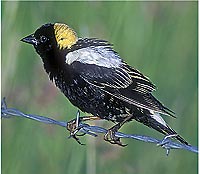Listen carefully: Do you hear a chattering, tweeting, or cooing that has been absent from the canyon country soundscape for a few months? Do you see glimpses of color moving in the trees? March through May marks the return of migratory birds in Utah, many of which travel to Arizona, Mexico, and even farther south to wait out the cold winter. For the return of these cheerful signs of spring, we can thank not only the sun, but the stars and the dark night sky.
 One of these birds, the Bobolink, migrates more than 12,000 miles from its wintering grounds in Argentina back to Utah every spring. But how do these birds and others like them find their way during such a long journey? There are many ways birds navigate, but for the thousands of Utah songbirds the moon and the stars provide the most vital compasses. Most songbirds migrate at night, flying at altitudes of 2,000 to 5,000 feet. Night time provides cooler temperatures that keep the birds from overheating during their strenuous journey, and provides a view of the stars that guide them home.
One of these birds, the Bobolink, migrates more than 12,000 miles from its wintering grounds in Argentina back to Utah every spring. But how do these birds and others like them find their way during such a long journey? There are many ways birds navigate, but for the thousands of Utah songbirds the moon and the stars provide the most vital compasses. Most songbirds migrate at night, flying at altitudes of 2,000 to 5,000 feet. Night time provides cooler temperatures that keep the birds from overheating during their strenuous journey, and provides a view of the stars that guide them home.
In 1957 two German scientists, Franz and Eleanor Saus did a series of experiments that demonstrated the importance of the night sky in songbird navigation. During these experiments, songbirds were raised inside enclosed planetary domes in groups that were shown different star patterns. When the fall migration started, the birds were released in the planetarium and demonstrated that as youngsters they had in fact learned to navigate using a rotational star pattern for orientation. Years later, scientists have even identified the specific star patterns used by birds like the Indigo Bunting.
But now this vital means of navigation is at risk. Bright city lights drown out the stars and draw migrating birds in like a trap. Birds get stuck in the cities and are unable to navigate out. They may fly in circles until they are exhausted or fly into buildings. “It presumably short-circuits birds’ visual clues, and they stay in the lit area” concluded Ornithologist Andrew Farnsworth, during a study on the subject for Cornell University. So what can we do to help our songbird friends? “We should turn off lights whenever and wherever we can”, Farnsworth says, “It makes a difference”.
Moon Happenings
Apr 12 - First Quarter at 1:05 pm
Apr 19 - Full Moon at 5:12 am
 One of these birds, the Bobolink, migrates more than 12,000 miles from its wintering grounds in Argentina back to Utah every spring. But how do these birds and others like them find their way during such a long journey? There are many ways birds navigate, but for the thousands of Utah songbirds the moon and the stars provide the most vital compasses. Most songbirds migrate at night, flying at altitudes of 2,000 to 5,000 feet. Night time provides cooler temperatures that keep the birds from overheating during their strenuous journey, and provides a view of the stars that guide them home.
One of these birds, the Bobolink, migrates more than 12,000 miles from its wintering grounds in Argentina back to Utah every spring. But how do these birds and others like them find their way during such a long journey? There are many ways birds navigate, but for the thousands of Utah songbirds the moon and the stars provide the most vital compasses. Most songbirds migrate at night, flying at altitudes of 2,000 to 5,000 feet. Night time provides cooler temperatures that keep the birds from overheating during their strenuous journey, and provides a view of the stars that guide them home.